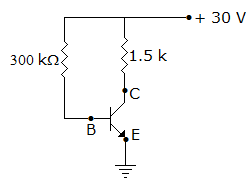Question

a.
IC = 10 mA, VCE = 15 V
b.
IC = 5 mA, VCE = 22.5 V
c.
IC = 5 mA, VCE = 15 V
d.
IC = 10 mA, VCE = 22.5 V
Posted under Electronics and Communication Engineering
Interact with the Community - Share Your Thoughts
Uncertain About the Answer? Seek Clarification Here.
Understand the Explanation? Include it Here.
Q. In figure the coordinates of Q point on the load line are (Neglect VBE)
Similar Questions
Explore Relevant Multiple Choice Questions (MCQs)
Q. In the re model of a BJT amplifier, the ac resistance of diode at room temperature is about (IE is quiescent emitter current)
View solution
Q. Symbol shown in figure represents a
View solution
Q. Figure shows basic Hartley oscillator configuration. Do you think the polarities marked for the split coiled are correct?
View solution
Q. In the case of the circuit shown in the figure, the collector current IC will be, if β = 100, VBE = 0.7 V, ICO = 0.1 βA at 20°C
View solution
Q. The circuit of figure is
View solution
Q. In figure VCE (sat) = 0.1 V. Then IC (sat) =
View solution
Q. The circuit shown in figure will
View solution
Q. For the circuit shown in the figure, the capacitor C is initially uncharged. At t = 0, the switch S is closed. The voltage Vc across the capacitor at t = 1 millisecond is (In the figure shown above, the op-amp is supplied with ± 15 V and the ground has been shown by the symbol)
View solution
Q. In figure, D2 turns on when
View solution
Q. Figure shows the feedback network of one of the very popular types of sinusoidal oscillators. Which one is that?
View solution
Q. In figure the trace on the CRO will be
View solution
Q. The circuit shown I/P in the figure represents
View solution
Q. To have a centred Q point in CE amplifier
View solution
Q. In figure the diode is ideal (zero cut in voltage zero forward resistance). Then the current through diode is
View solution
Q. The circuit shown in the figure is that of
View solution
Q. Circuit shown in the figure is
View solution
Q. The period of oscillation of a symmetrical multivibrator depends upon the discharging time constant and is roughly given by
View solution
Q. Symbol shown in figure represents a
View solution
Q. In figure it is desired that output wave is symmetrical. Then
View solution
Q. The circuit shown in figure will act as
View solution
Recommended Subjects
Are you eager to expand your knowledge beyond Electronics and Communication Engineering? We've handpicked a range of related categories that you might find intriguing.
Click on the categories below to discover a wealth of MCQs and enrich your understanding of various subjects. Happy exploring!








